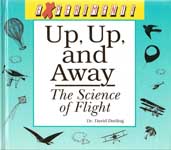UP, UP, AND AWAY: The Science of Flight - 4. Flight with a Twist

Figure 1. Helicopters can move in ways that a fixed wing airplane cannot.

Figure 2. The main forces acting on a helicopter in flight.

Figure 3. How to a model helicopter.

Figure 4. Boeing Chinook.

Figure 5. Students at a California University became the first ever to fly a human-powered helicopter. The whole machine weighs only 97 pounds and had two pedal-driven rotors spanning nearly 100 feet. Its first flight, in December 1989, lasted for 7 seconds and took it 8 inches off the ground.

Figure 6. Students at a California University became the first ever to fly a human-powered helicopter. The whole machine weighs only 97 pounds and had two pedal-driven rotors spanning nearly 100 feet. Its first flight, in December 1989, lasted for 7 seconds and took it 8 inches off the ground.
One of the problems with most airplanes is that they need a lot of room in which to take off and land. Also, they cannot simply hover in one place. They have to be moving forward all the time so that the air rushing over their wings can provide them with lift.
A helicopter, however, does not suffer from these disadvantages. That is because its "wings" are in the form of a giant horizontal propeller known as a rotor that spins around very quickly. Each of the long, thin blades of the rotor has the shape of an airfoil. As these blades ct through the air at high speed, they provide the helicopter with lift, whether it is going straight up, hovering, flying forward, or flying backward. To move in these different ways, all the pilot has to do is tilt the rotor slightly in the direction he or she wants to go.
Helicopters can perform tasks that would be impossible for an ordinary fixed-wing plane. For example, they can hover above a rough sea of the side of a mountain and help to rescue people who are injured or stranded. They can land at special heliports or helipads, even in the middle of busy cities. And they can rush victims of a road accident to the rooftop landing pad of a major hospital.

Going for a Spin
You will need:
What to do: Draw the shape shown here onto the cardboard using the measurements given.
Be sure to mark on the dotted lines as well. Cut out the shape. This will be the rotor of your model helicopter.
Glue the plastic spool to the rotor, being careful to position it exactly in the center. Allow the glue to dry. Bend the rotors down slightly along the lines of the center square. Also bend the rotors along diagonal lines as shown. When you look at them from the side, the rotors should have a slight droop and twist that will allow them to slice through the air as they spin.
Wind the thread or string about 15 times around the reel, making sure that the loose end is securely held by the windings. Put the spool onto the pencil, hold it upright, and pull hard on the thread.
What happens if you point the pencil at an angle during the launch? What happens if you alter the amount of droop and twist of the rotor blades?
Taking it further: Try making a number of different helicopters, altering the size, number, and folding of the rotors. Which design works best? Can you explain why? |
An Extra Twist
If a helicopter had just a single rotor, it would be impossible to control. The reason is that as the big rotor spins around in one direction it tends to make the rest of the aircraft twist in the opposite direction. One way to cancel out this effect is to mount a smaller rotor facing sideways on the tail. This creates a twisting force that is exactly equal and opposite to that produced by the main rotor.
Another way to keep a helicopter steady is to have two main rotors spinning in opposite directions. This is the method often used on large helicopters that are built to carry heavy loads. A twin rotor helicopter, such as the Boeing Chinook, can generate more lift than an ordinary single rotor craft. It also needs no tail rotor.
Vertical Takeoff
Not all airplanes need runways. The British Aerospace Harrier, for example, can rise straight up off the ground, hover, and even fly backward! Air, taken in by the Harrier's single jet engine, is compressed and then blasted out of four nozzles, two on each side of the aircraft. For takeoff and landing, these nozzles are angled straight down to provide vertical thrust. Smaller air jets called "puffers," at the tips of the wings and at each end of the aircraft's body, allow the pilot to steady the Harrier when it is hovering. Once the plane is off the ground, the nozzles can be gradually swiveled back to push the Harrier forward up to a maximum speed of 720 miles per hour.

